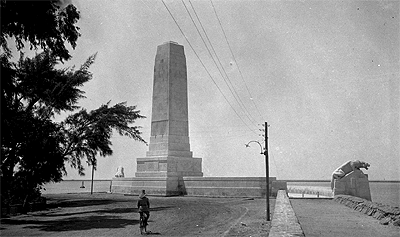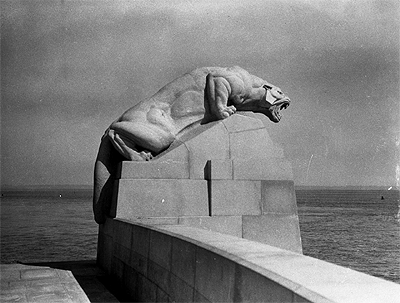 |
 |
|
Situated at the south end (Port of Suez) of the Suez Canal, the site was originally designated for the stature of Ferdinand de Lesseps with the Lady of the Lamp (Statue of Liberty) due to be installed at the north end (Port Said). It was not until money ran out during the construction of the Suez Canal, that the Lady of the Lamp could no longer be afforded to be purchased from the French (and was subsequently bought by the U.S.A. and renamed the Statue of Liberty) that plans changed for the de Lessep’s statue to be placed at the north entrance of the Canal, leaving the south end with nothing at it’s entrance. The Port Tewfik Memorial was unveiled in May 1926 for the Imperial War Graves Commissions and commemorated the 3,727 officers and men of the Indian Army killed during the Sinai and Palestine Campaign during WWI. It was designed by Scottish architects John James Burnet and Thomas S. Tait and included sculptures by British sculptor Charges Sargeant Jagger. No names ever appeared on the memorial when it was unveiled, only the names of the units and regiments as the Commission had not been satisfied with the records of the missing men provided by the Army. Its two crouching tigers, embodying the Indian Army, stood guard over the entrance to the Suez Canal, the vital artery of Empire. Their wide-open mouths and bared teeth called on thousands who passed by to look up and recall the memory of those who gave their lives in Egypt and Palestine. The memorial was destroyed by retreating Egyptian troops during the Six-Day War of 1967. In the 1970’s the Commission strove to restore it but it became clear that a replacement memorial could not be built on the same site due to the area’s instability and the fact that a towering power mast had been hastily erected within metres of the ruins. So it was decided to build the new memorial within the grounds of Heliopolis War Cemetery, near Cairo, 75 miles east. The Commission took the opportunity to redress the historical inequality and included all the names on the new memorial, so now all 3,727 men are commemorated there. New tigers also guard their memory. The symbolic spirit of the Indian Army was replicated in the new design with three bronze tigers placed at each of the cemetery’s entrances. The tigers, still couching; the names no longer hidden. | |